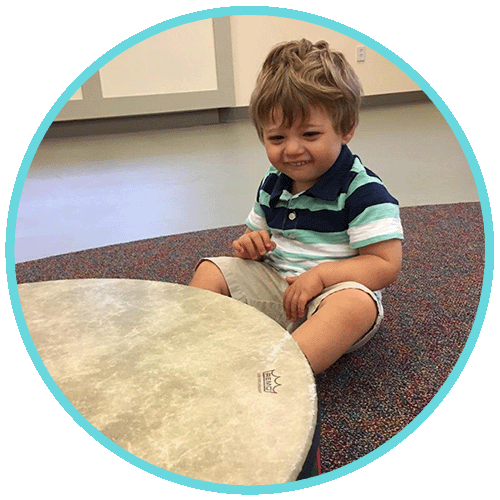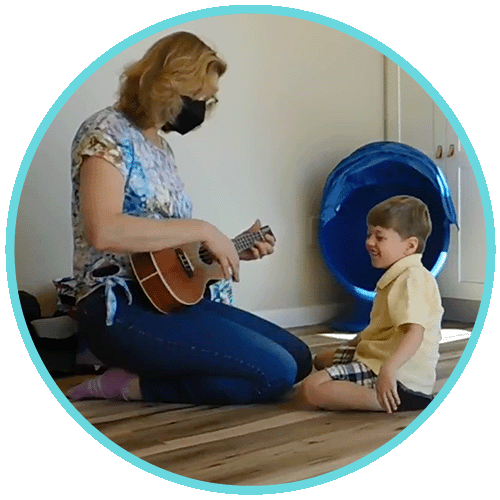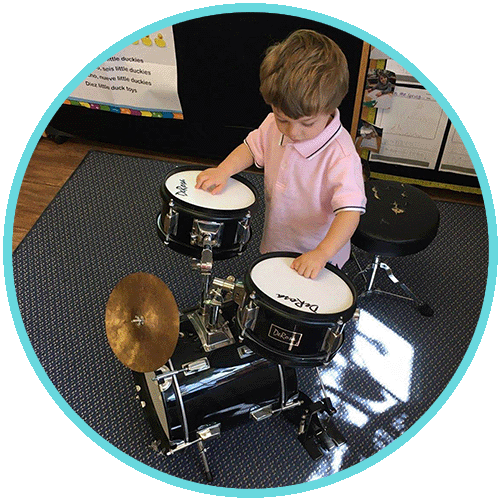The Michaels Family: Max’s Musical Journey
Whether you're a kid who wants to dance in circles or you want to sit and watch the action, there's a space for you at Music Together®!

When their son, Max, was just about a year old, Robin Michaels and John Alastick signed him up for a Music Together class, not realizing that small step would have a major impact on their family. Max, now six, was born with an ultra-rare genetic disorder called Cohen Syndrome, and Music Together and music therapy have been a big part of his early learning.
“At first, Max would just sit, wide-eyed, taking everything in, not crawling around like some of the other kids, but I could see him responding to the rhythm and that the music spoke to him,” Robin remembers. “We kept coming to class, with new experiences each time. Because he had difficulty with movement, he’d try to pull items toward himself rather than going towards them, but we saw gradual gains because he and his senses were so engaged. As Max grew older and started to diverge from his neurotypical peers, we found that Music Together provided an easier structure for him to integrate and assimilate with other kids.”
Cohen Syndrome is a genetic disorder that causes a host of issues that affect the whole body: immune issues, severe vision impairment, and significant motor-planning, speech, and developmental challenges. Children with Cohen Syndrome tend to be friendly and social, but it can be difficult for them to communicate, with many relying on electronic devices to “talk.” Max is one of about 1000 children worldwide with the condition, with more being diagnosed every day now that genetic testing is becoming more common.
Since fine- and gross-motor skills are harder for those with Cohen Syndrome, it’s important for children to be motivated to do activities that build these abilities. For Max, music was hugely motivating, so Robin decided to embrace that and engage a music therapist to work with him in addition to continuing to attend Music Together classes.
Music Together® and Music Together Within Therapy®

Robin shared that it was an “amazing, lucky coincidence,” when she was referred to Dr. Carol Ann Blank, a central NJ board-certified music therapist who also leads Special Needs Services at Music Together Worldwide. During their music therapy sessions, Carol Ann, a Music Together Within Therapy provider, used Max’s favorite Music Together songs and activities, which helped him focus and stay grounded in the therapeutic experience. He really responded!
Max and his family continued to attend Music Together family classes, sometimes joined by Carol Ann and Max’s aide, Katrina. Carol Ann says, “The really great thing about having the songs that we do in therapy be the same songs that happen in class is that we can take as much time as Max needs on a particular song, to finally allow him to rally his whole body to do the thing that we know he wanted to do.”
At one particular therapy session, they were working on fine motor skills, with the goal for Max to shake his instrument (that produced a sound he loved) with one hand. They alternated between the Music Together songs “Little Blue Car” and “Ding a Ding,” while Carol Ann, Robin, and Katrina sang and shook along while Max roamed the room holding his shaker. Then, after twenty minutes, he made eye contact and shook it, very deliberately. “It made my entire week!” Carol Ann said.
In addition, Max’s condition involves some ”sensory defensiveness,” a disorder where normal sensations can be difficult to tolerate. By interacting with musical instruments, like drums and shakers, Max has overcome much of his fear of touching items. In fact, Max became fascinated with a ukulele Carol Ann brought to one of his sessions, and it became an excellent tool for teaching him various motor skills. They took their time, unzipping the case, and eventually holding the ukulele and strumming. Now, Max has his own ukulele and he and Carol Ann play together.
Robin summarizes, “When Carol Ann first came in to do music therapy, Max was in his own world. He used to not really give eye contact and wouldn't reach out and touch things. Now, he actively engages. He's making more sounds than ever, and he vocalizes a lot more with music. I’ve witnessed the power of music to completely unlock him, which is just phenomenal.”
Music Together and Music Together Within Therapy:
Options for Families with Children with Special Needs
Music is a powerful tool that can open doors for children with special needs, including cognitive, social, physical, and neurological impairments. Everyone, regardless of age, stage, or learning style, is welcome to join the inviting, relaxed musical community in a Music Together family class. And, in Music Together Within Therapy, we partner with board-certified music therapists, speech therapists, counselors, and other credentialed allied health professionals to offer individual and small-group therapy for kids with special needs. Music Together Within Therapy uses the Music Together recordings and songbooks, as well as materials designed specifically for clinical use.
- To find a Music Together Within Therapy provider, please email therapy@musictogether.com.
- If you’re an allied health professional interested in using Music Together to enhance your work with individual clients, visit our website to learn more about how you can become a therapy provider.
Music and Self-expression

In addition to supporting his therapeutic goals, music has become a way for Max to express himself and share his interests. Since he is not yet able to speak, this has helped his parents get to know things about him that they might have otherwise missed. Robin says, “Max has excellent pitch, and there are parts of songs that really make him laugh, like the little noises in 'The Sad Little Puppy.' He also likes the Israeli-sounding folksongs. These are things that we would not have otherwise gotten to know about him, because we didn't have any way to explore them before Music Together. I can't see a time when he'll ever not love that music.”
Music and Community
Music Together has also given Max and his parents a place where they can be a part of a community. For families with children with special needs, it can be a challenge to find activities they can comfortably engage in for prolonged periods of time, with or without typically developing siblings. Accepting and including all of our music-makers, the big ones and the little ones, is a key part of our philosophy, so for as long as Max is interested, he and his family will always be welcome to attend Music Together classes.
Robin says, “There's a preciousness to this program that lets everybody come as they are and truly be included. It can meet you where you're at and everyone can participate in ways that are slightly different and be completely accepted. It’s a unifier of different people: You can be in a wheelchair, or vision-impaired, and still enjoy and be active with music, within Music Together. There's a magical quality in that. Whether you're a kid who wants to dance in circles or you want to sit and watch the action, there's a space for you!”
Robin and her family have become active with advocacy for Cohen Syndrome, and recently participated in the University of Pennsylvania Orphan Disease Center’s Million Dollar Bike Ride event, raising money for research into ultra-rare diseases like Cohen Syndrome. Research is a crucial tool for rare disease, and can help drive better outcomes. You can learn more about Cohen Syndrome and the Cohen Syndrome Champions team at www.coh1.org.



